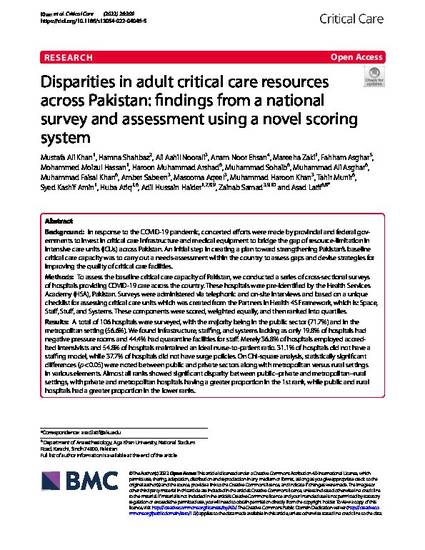
Background: In response to the COVID-19 pandemic, concerted efforts were made by provincial and federal governments to invest in critical care infrastructure and medical equipment to bridge the gap of resource-limitation in intensive care units (ICUs) across Pakistan. An initial step in creating a plan toward strengthening Pakistan's baseline critical care capacity was to carry out a needs-assessment within the country to assess gaps and devise strategies for improving the quality of critical care facilities.
Methods: To assess the baseline critical care capacity of Pakistan, we conducted a series of cross-sectional surveys of hospitals providing COVID-19 care across the country. These hospitals were pre-identified by the Health Services Academy (HSA), Pakistan. Surveys were administered via telephonic and on-site interviews and based on a unique checklist for assessing critical care units which was created from the Partners in Health 4S Framework, which is: Space, Staff, Stuff, and Systems. These components were scored, weighted equally, and then ranked into quartiles.
Results: A total of 106 hospitals were surveyed, with the majority being in the public sector (71.7%) and in the metropolitan setting (56.6%). We found infrastructure, staffing, and systems lacking as only 19.8% of hospitals had negative pressure rooms and 44.4% had quarantine facilities for staff. Merely 36.8% of hospitals employed accredited intensivists and 54.8% of hospitals maintained an ideal nurse-to-patient ratio. 31.1% of hospitals did not have a staffing model, while 37.7% of hospitals did not have surge policies. On Chi-square analysis, statistically significant differences (p < 0.05) were noted between public and private sectors along with metropolitan versus rural settings in various elements. Almost all ranks showed significant disparity between public-private and metropolitan-rural settings, with private and metropolitan hospitals having a greater proportion in the 1st rank, while public and rural hospitals had a greater proportion in the lower ranks.
Conclusion: Pakistan has an underdeveloped critical care network with significant inequity between public-private and metropolitan-rural strata. We hope for future resource allocation and capacity development projects for critical care in order to reduce these disparities.
Available at: http://works.bepress.com/adil_haider/173/

Pagination are not provided by the author/publisher